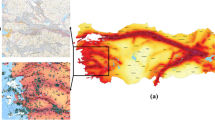Abstract
A systematic robust design optimization methodology is presented in this study for cantilever retaining wall backfilled with shredded tire in the face of earthquake hazards. Regarding the merits of application of shredded tire backfill in seismically active areas, the uncertainties in properties of this material (e.g., friction angle and cohesion) as well as uncertainties in earthquake load (e.g., peak ground acceleration) necessitate examining the robustness of design along cost efficiency in geotechnical design procedures. The wall tip deflection was treated as the response of concern for which a response surface was developed based on the design and random (uncertain) variables. Coupling with Monte Carlo simulations, the optimization in terms of cost and standard deviation of response as a measure of robustness yielded a set of preferred designs, or Pareto front, and the final optimal design was determined via selection procedures based on knee point concept.











Similar content being viewed by others
References
Ahmed I, Lovell CW (1993) Rubber soil as light weight geomaterials. Transp Res Rec:61–70
Andrews DW, and Guay MA (1996) “Tire chips in a superfund landfill cap: a case history of the first use of a tire chip drain layer.” Nineteenth International Madison Waste Conference, Dept. of Engineering Professional Development, University of Wisconsin-Madison
Babu GLS, Basha BM (2008) Optimum design of cantilever retaining walls using target reliability approach. Int J Geomechanics 8:240–252
Balunaini U, Yoon S, Prezzi M and Salgado R (2009) “Final report: tire shred backfill in mechanically stabilized earth wall application.” FHWA/NA/JTRP, 2008/17
Black BA, Shakoor A (1994) A geotechnical investigation of soil-tire mixtures for engineering applications. In: Proceedings of the first international conference on environmental Geotechnics, Bitech publications, pp 617–623
Bosscher PJ, Edil TB, Kuraoka S (1997) Design of highway embankments using tire chips. J Geotech Geoenviron 123(4):295–304
Bressette T (1984) “Used tire material as an alternate permeable aggregate.” State of California, Department of Transportation, Division of Engineering Services, Office of Transportation Laboratory, Sacramento, CA
Camp CV, Akin A (2011) Design of retaining walls using big bang–big crunch optimization. J Struct Eng 138(3):438–448
Cecich V, Gonzales I, Hoisaeter A, Williams J and Reddy K (1996) “Use of shredded tire as lightweight backfill material for retaining structures.” Waste Management & Research, No 14, pp. 433–451
Ceranic B, Fryer C, Baines RW (2001) An application of simulated annealing to the optimum design of reinforced concrete retaining structures. Comput Struct 79(17):1569–1581
Cornell CA, Banon H, Shakal AF (1979) Seismic motion and response prediction alternatives. Earthq Eng Struct Dyn 7(4):295–315
Cosgrove TA (1995) “Interface strength between tire chips and geomembrane for use as a drainage layer in a landfill cover.” Proceedings of Geosynthetics'95, Industrial Fabrics Association, St Paul, MN, 3:1157–1168
Dang HP, Lin HD, Juang CH (2014) Analyses of braced excavation considering parameter uncertainties using a finite element code. J Chin Inst Eng 37(2):141–151
Djadouni H, Trouzine H, Correia AG, da Silva Miranda TF (2019) Life cycle assessment of retaining wall backfilled with shredded tires. Int J Life Cycle Assess 24(3):581–589
Deb K, Pratap A, Agarwal S (2002) A fast and elitist multiobjective genetic algorithm NSGA-II. Evol Comput 6(2):182–197
Duffy DP (1995) Using tire chips as a leachate drainage layer. Waste Age 26(9):113–122
Dwyer DF (2008) Technical report: tire shred initiative: summary report. State of New York Department of Transportation, Geotechnical Engineering Bureau
Eldin NN, Senouci AB (1992) Use of scrap tires in road construction. J Constr Eng Manag 118(3):561–576
Edil TB, Bosscher PJ (1994) Engineering properties of tire chips and soil mixtures. Geotech Test J 17(4):453–464
Foose GJ, Benson CH, Bosscher PJ (1996) Sand reinforced with shredded waste tires. J Geotech Eng 122:760–767
Gharegrat H (1993) Finite element analyses of pavements underlain by a tire chip layer and of retaining walls with tire chip backfill. Department of Civil Engineering, University of Maine, M.S. Thesis
Gebhardt MA (1997) Shear strength of shredded tires as applied to the design and construction of a shredded tire stream crossings. Iowa State University, MS Thesis
Hataf N, Rahimi MM (2006) Experimental investigation of bearing capacity of sand reinforced with randomly distributed tire shreds. Construction and Building Materials, No 20:910–916
Head D, Picornell M and Nash PT (2001) “Report: El Paso embankment fill with shredded tire.” Texas Department of Transportation
Huang Y, Hu H, Xiong M (2018) Probability density evolution method for seismic displacement-based assessment of earth retaining structures. Eng Geol 234:167–173
Huggins L (2014) Numerical and reliability analysis of gravity cantilever retaining walls backfilled with shredded tires subjected to seismic loads. Clemson University, Clemson, SC, M.S. Thesis
Humphrey DN, Sandford TC, Cribbs MM, Manion WP (1993) Shear strength and compressibility of tire chips for use as retaining wall backfill. Transp Res Rec 14:433–451
Juang CH, Wang L, Atamturktu S, and Luo Z (2012) Reliability-based robust and optimal design of shallow foundations in cohesionless soil in the face of uncertainty. J Geoengin 7(3):75–87
Juang CH, Liu Z and Atamturktur HS (2013a) “Reliability-based robust geotechnical design of retaining walls.” Sound Geotechnical Research to Practice, pp. 514–524
Juang CH, Wang L, Liu Z, Ravichandran N, Huang H, Zhang J (2013b) Robust geotechnical design of drilled shafts in sand: new design perspective. J Geotech Geoenviron 139(12):2007–2019
Khoshnevisan S, Gong W, Wang L and Juang CH (2014) “Robust design in geotechnical engineering–an update.” Georisk: Assessment and Management of Risk for Engineered Systems and Geohazards, 8(4), 217–234
Khuri AI, Mukhopadhyay S (2010) Response surface methodology. WIREs Comput Stat 2:128–149
Lee JH, Salgado R, Bernal A, Lovell CW (1999) Shredded tires and rubber sand as lightweight backfill. J Geotech Geoenviron 125(2):132–141
Li DQ, Zheng D, Cao ZJ, Tang XS, Phoon KK (2016) Response surface methods for slope reliability analysis: review and comparison. Eng Geol 203:3–14
Liu Z, Juang CH, Atamturktur S (2013) Confidence level-based robust design of cantilever retaining walls in sand. Comput Geotech 52:16–27
Luo Z, and Hu B (2019) “Robust design of energy piles using a fuzzy set-based point estimate method.” Cold Regions Science and Technology, 102874
Luo Z, Hu B, Pan E (2019) Robust design approach for flexible pavements to minimize the influence of material property uncertainty. Constr Build Mater 225:332–339
Masad E, Taha R, Ho C, Papagiannakis T (1996) Engineering properties of tire/soil mixtures as a lightweight fill material. Geotech Test J 19(3):297–304
Moo-Young H, Sellasie K, Zeroka D, Sabins G (2003) Physical and chemical properties of tire shreds for use in construction. J Environ Eng 129(10):921–929
Mononobe H (1924) Considerations into earthquake vibrations and vibration theories. J Japan Soc Civil Eng 10(5):1063–1094
Moriasi DN, Arnold JG, Van Liew MW, Bingner RL, Harmel RD, Veith TL (2007) Model evaluation guidelines for systematic quantification of accuracy in watershed simulations. Trans ASABE 50(3):885–900
Okabe S (1924) General theory on earth pressure and seismic stability of retaining wall and dam. Proc Civil Eng Soc Japan 10(6):1277–1323
Papazafeiropoulos G, Plevris V, Papadrakakis M (2013) Optimum design of cantilever walls retaining linear elastic backfill by use of genetic algorithm. COMPDYN 2013
Phoon KK, Kulhawy FH (1999) Characterization of geotechnical variability. Can Geotech J 36(4):612–624
Phoon KK, Ching J (2014) Risk and reliability in geotechnical engineering. CRC Press
Pei Y, Xia Y (2012) Design of reinforced cantilever retaining walls using heuristic optimization algorithms. Procedia Earth Planet Sci 5:32–36
Peng X, Li DQ, Cao ZJ, Gong W, Juang CH (2017) Reliability-based robust geotechnical design using Monte Carlo simulation. Bull Eng Geol Environ 76(3):1217–1227
PLAXIS (2019) PLAXIS 2D reference manual; Bentley Systems International Limited, Dublin, Ireland
Rahbari P, Ravichandran N and Juang CH (2016) “Reliability-based robust geotechnical design of retaining wall backfilled with shredded tire under dynamic loads.” Geotechnical and Structural Engineering Congress, Phoenix, Arizona
Ravichandran N, Huggins L (2013) Seismic response of gravity-cantilever retaining wall backfilled with shredded tire. Geotech Eng J SEAGS & AGSSEA 44(3):14–24
RecycleNet. (2019) Retrieved from www.recyclenet.com. Accessed 18 April 2019
Reddy SB, Krishna AM (2015) Recycled Tire chips mixed with sand as lightweight backfill material in retaining wall applications: an experimental investigation. Int J Geosynthetics Ground Eng 1(4):1–11
Reddy KR, Stark TD, and Marella A (2009) “Beneficial use of shredded tires as drainage material in cover systems for abandoned landfills.” Practice Periodical of Hazardous, Toxic, and Radioactive Waste Management, 14(1), 47–60
Saribas A, Erbatur F (1996) Optimization and sensitivity of retaining structures. J Geotech Eng 122(8):649–656
Shalaby A, Khan RA (2005) Design of unsurfaced roads constructed with large-sized shredded rubber tires: a case study. Resour Conserv Recycl 44:318–332
Shrestha S, Ravichandran N, Raveendra M, Attenhofer JA (2016) Design and analysis of retaining wall backfilled with shredded tire and subjected to earthquake shaking. Soil Dyn Earthq Eng 90:227–239
Siyahi B, Arslan H (2008) Earthquake induced deformation of earth dams. Bull Eng Geol Environ 67(3):397–403
Song L (2011) “NGPM - A NSGA-II program in Matlab.” Aerospace Structural Dynamics Research Laboratory, College of Astronautics, Northwestern Polytechnical University, China
Tang L, Cong S, Xing W, Ling X, Geng L, Nie Z, Gan F (2018) Finite element analysis of lateral earth pressure on sheet pile walls. Eng Geol 244:146–158
Tatlisoz N, Edil TB, Benson C (1998) Interaction between reinforcing geosynthetics and soil-tire chip mixtures. J Geotech Geoenviron Eng 124(11):1109–1119
Tweedie JJ, Humphrey DN, Sandford TC (1998) Tire shreds as lightweight retaining wall backfill: active conditions. J Geotech Geoenviron Eng 124:1061–1070
Vecoplan LLC (2019) Retrieved from www.vecoplanllc.com. Accessed 1 Oct 2019
Warith MA, Evgin E, Benson PAS (2004) Suitability of shredded tires for use in landfill leachate collection systems. Waste Management, No 24:967–979
Wang L, Hwang JH, Juang CH, Atamturktur S (2013) Reliability-based design of rock slopes—a new perspective on design robustness. Eng Geol 154:56–63
Wang L, Juang CH, Atamturktur S, Gong W, Khoshnevisan S, Hsieh HS (2014) Optimization of design of supported excavations in multi-layer strata. J GeoEng 9(1):1–12
Wang Z, Yu Y, Sun H, Lü Q, Shang Y (2019) Robust optimization of the constructional time delay in the design of double-row stabilizing piles. Bull Eng Geol Environ:1–15
Wu W, Benda C, Cauley R (1997) Triaxial determination of shear strength of tire chips. J Geotech Geoenviron Eng ASCE 123(5):479–482
Xu YS, Shen SL, Ma L, Sun WJ, Yin ZY (2014) Evaluation of the blocking effect of retaining walls on groundwater seepage in aquifers with different insertion depths. Eng Geol 183:254–264
Yang S, Lohnes RA, Kjartanson BH (2002) Mechanical properties of shredded tires. Geotech Test J 25(1):44–52
Yepes V, Alcala J, Perea C, González-Vidosa F (2008) A parametric study of optimum earth-retaining walls by simulated annealing. Eng Struct 30(3):821–830
Youwai S, Bergado DT (2003) Strength and deformation characteristics of shredded rubber tire-sand mixtures. Can Geotech J 40(2):254–264
Yu Y, Shen M, Sun H, Shang Y (2019) Robust design of siphon drainage method for stabilizing rainfall-induced landslides. Eng Geol 249:186–197
Zhang J, Wang H, Huang HW, Chen LH (2017) System reliability analysis of soil slopes stabilized with piles. Eng Geol 229:45–52
Zheng D, Li DQ, Cao ZJ, Tang XS, Phoon KK (2017) An analytical method for quantifying the correlation among slope failure modes in spatially variable soils. Bull Eng Geol Environ 76(4):1343–1352
Zhou XP, Huang XC (2018) Reliability analysis of slopes using UD-based response surface methods combined with LASSO. Eng Geol 233:111–123
Funding
This research was supported by Glenn Department of Civil Engineering, Clemson University. The second author also wishes to acknowledge the support from the National Science Foundation (Award #1900445).
Author information
Authors and Affiliations
Corresponding author
Ethics declarations
Disclaimer
The results and opinions expressed in this paper do not necessarily reflect the views and policies of the National Science Foundation.
Rights and permissions
About this article
Cite this article
Ravichandran, N., Wang, L., Rahbari, P. et al. Robust design optimization of retaining wall backfilled with shredded tire in the face of earthquake hazards. Bull Eng Geol Environ 80, 1351–1363 (2021). https://doi.org/10.1007/s10064-020-02038-9
Received:
Accepted:
Published:
Issue Date:
DOI: https://doi.org/10.1007/s10064-020-02038-9




